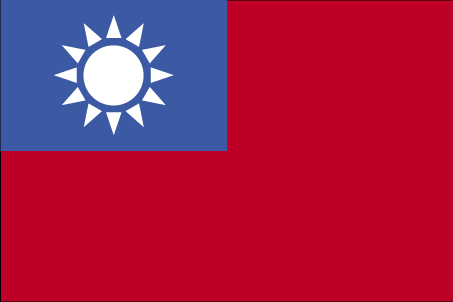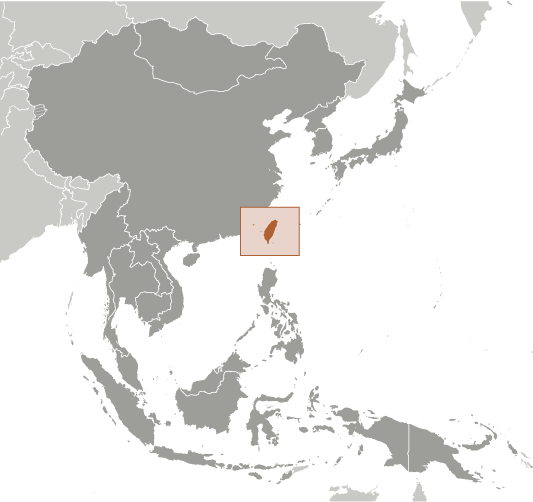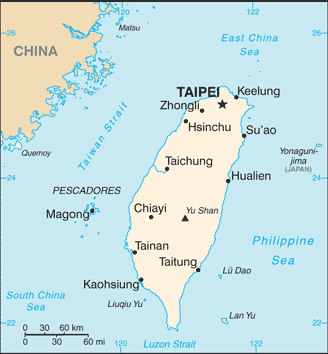|
Economy - overview:
|

|
|
Taiwan has a dynamic capitalist economy with gradually decreasing government guidance of investment and foreign trade. Exports, led by electronics, machinery, and petrochemicals have provided the primary impetus for economic development. This heavy dependence on exports exposes the economy to fluctuations in world demand. In 2009, Taiwan's GDP contracted 1.8%, due primarily to a 13.1% year-on-year decline in exports. In 2010 GDP grew 10.7%, as exports returned to the level of previous years, and in 2011, grew 4.1%. In 2012, however, growth fell to 1.3%, because of softening global demand. Taiwan's diplomatic isolation, low birth rate, and rapidly aging population are major long-term challenges. Free trade agreements have proliferated in East Asia over the past several years, but except for the landmark Economic Cooperation Framework Agreement (ECFA) signed with China in June 2010, so far Taiwan has been excluded from this greater economic integration in part because of its diplomatic status. Negotiations continue on such follow-on components of ECFA regarding trade in goods and services. The MA administration has said that the ECFA will serve as a stepping stone toward trade pacts with other key trade partners, which Taiwan subsequently launched with Singapore and New Zealand. Taiwan's Total Fertility rate of just over one child per woman is among the lowest in the world, raising the prospect of future labor shortages, falling domestic demand, and declining tax revenues. Taiwan's population is aging quickly, with the number of people over 65 accounting for 11.2% of the island's total population as of 2012. The island runs a large trade surplus largely because of its surplus with China, and its foreign reserves are the world's fifth largest, behind China, Japan, Saudi Arabia, and Russia. In 2006 China overtook the US to become Taiwan's second-largest source of imports after Japan. China is also the island's number one destination for foreign direct investment. Three financial memorandums of understanding, covering banking, securities, and insurance, took effect in mid-January 2010, opening the island to greater investments from the mainland's financial firms and institutional investors, and providing new opportunities for Taiwan financial firms to operate in China. In August 2012, Taiwan Central Bank signed a memorandum of understanding on cross-Strait currency settlement with its Chinese counterpart. The MOU allows for the direct settlement of Chinese RMB and the New Taiwan dollar across the Strait, which could help develop Taiwan into a local RMB hub. Closer economic links with the mainland bring greater opportunities for the Taiwan economy, but also poses new challenges as the island becomes more economically dependent on China while political differences remain unresolved.
|
|
|
GDP (purchasing power parity):
|

|
|
$901.9 billion (2012 est.)
country comparison to the world: 20
$890.2 billion (2011 est.)
$855.7 billion (2010 est.)
note:
data are in 2012 US dollars
|
|
|
GDP (official exchange rate):
|

|
|
$474.1 billion (2012 est.)
|
|
|
GDP - real growth rate:
|

|
|
1.3% (2012 est.)
country comparison to the world: 149
4% (2011 est.)
10.7% (2010 est.)
|
|
|
GDP - per capita (PPP):
|

|
|
$38,500 (2012 est.)
country comparison to the world: 30
$38,300 (2011 est.)
$36,900 (2010 est.)
note:
data are in 2012 US dollars
|
|
|
GDP - composition by sector:
|

|
|
agriculture: 1.7%
industry:
29.7%
services:
68.6% (2012 est.)
|
|
|
Labor force:
|

|
|
11.3 million (2012 est.)
country comparison to the world: 48
|
|
|
Labor force - by occupation:
|

|
|
agriculture: 5%
industry:
36.2%
services:
58.8% (2012 est.)
|
|
|
Unemployment rate:
|

|
|
4.3% (2012 est.)
country comparison to the world: 37
4.4% (2011 est.)
|
|
|
Population below poverty line:
|

|
|
1.45% (2012 est.)
|
|
|
Household income or consumption by percentage share:
|

|
|
lowest 10%: 6.4%
highest 10%:
40.3% (2010)
|
|
|
Distribution of family income - Gini index:
|

|
|
34.2 (2011)
country comparison to the world: 91
32.6 (2000)
|
|
|
Investment (gross fixed):
|

|
|
19.5% of GDP (2012 est.)
country comparison to the world: 105
|
|
|
Budget:
|

|
|
revenues: $57.6 billion
expenditures:
$64.62 billion (2012 est.)
|
|
|
Taxes and other revenues:
|

|
|
12.1% of GDP (2012 est.)
country comparison to the world: 203
|
|
|
Budget surplus (+) or deficit (-):
|

|
|
-1.5% of GDP (2012 est.)
country comparison to the world: 69
|
|
|
Public debt:
|

|
|
36% of GDP (2012 est.)
country comparison to the world: 100
34.9% of GDP (2011 est.)
note:
data for central government
|
|
|
Inflation rate (consumer prices):
|

|
|
1.9% (2012 est.)
country comparison to the world: 29
1.4% (2011 est.)
|
|
|
Central bank discount rate:
|

|
|
1.875% (31 December 2012)
country comparison to the world: 114
1.875% (31 December 2011)
|
|
|
Commercial bank prime lending rate:
|

|
|
2.88% (31 December 2012 est.)
country comparison to the world: 178
2.88% (31 December 2011 est.)
|
|
|
Stock of narrow money:
|

|
|
$407.8 billion (31 December 2012 est.)
country comparison to the world: 13
$388.7 billion (31 December 2011 est.)
|
|
|
Stock of broad money:
|

|
|
$1.119 trillion (31 December 2012 est.)
country comparison to the world: 17
$1.082 trillion (31 December 2011 est.)
|
|
|
Stock of domestic credit:
|

|
|
$772 billion (31 December 2012 est.)
country comparison to the world: 20
$698.3 billion (31 December 2011 est.)
|
|
|
Market value of publicly traded shares:
|

|
|
$831.9 billion (31 December 2012)
country comparison to the world: 18
$784.1 billion (31 December 2011)
$738.3 billion (31 December 2010)
|
|
|
Agriculture - products:
|

|
|
rice, vegetables, fruit, tea, flowers; pigs, poultry; fish
|
|
|
Industries:
|

|
|
electronics, communications and information technology products, petroleum refining, armaments, chemicals, textiles, iron and steel, machinery, cement, food processing, vehicles, consumer products, pharmaceuticals
|
|
|
Industrial production growth rate:
|

|
|
-0.1% (2012 est.)
country comparison to the world: 148
|
|
|
Current account balance:
|

|
|
$40.88 billion (2012 est.)
country comparison to the world: 12
$41.6 billion (2011 est.)
|
|
|
Exports:
|

|
|
$301.1 billion (2012 est.)
country comparison to the world: 20
$308.3 billion (2011 est.)
|
|
|
Exports - commodities:
|

|
|
electronics, flat panels, machinery; metals; textiles, plastics, chemicals; optical, photographic, measuring, and medical instruments
|
|
|
Exports - partners:
|

|
|
China 28.1%, Hong Kong 13.8%, US 11.5%, Japan 6.6%, Singapore 4.4% (2010 est.)
|
|
|
Imports:
|

|
|
$270.7 billion (2012 est.)
country comparison to the world: 20
$281.6 billion (2011 est.)
|
|
|
Imports - commodities:
|

|
|
electronics, machinery, crude petroleum, precision instruments, organic chemicals, metals
|
|
|
Imports - partners:
|

|
|
Japan 20.7%, China 14.2%, US 10%, South Korea 6.4%, Saudi Arabia 4.7% (2010 est.)
|
|
|
Reserves of foreign exchange and gold:
|

|
|
$408.5 billion (31 December 2012 est.)
country comparison to the world: 6
$390.6 billion (31 December 2011 est.)
|
|
|
Debt - external:
|

|
|
$127.4 billion (31 December 2012 est.)
country comparison to the world: 37
$122.5 billion (31 December 2011 est.)
|
|
|
Stock of direct foreign investment - at home:
|

|
|
$58.4 billion (31 December 2012 est.)
country comparison to the world: 51
$56.15 billion (31 December 2011 est.)
|
|
|
Stock of direct foreign investment - abroad:
|

|
|
$220.8 billion (31 December 2012 est.)
country comparison to the world: 21
$213.1 billion (31 December 2011 est.)
|
|
|
Exchange rates:
|

|
|
New Taiwan dollars (TWD) per US dollar -
29.62 (2012 est.)
29.47 (2011 est.)
31.648 (2010 est.)
33.061 (2009)
31.53 (2008)
|
|
|
Fiscal year:
|

|
|
calendar year
|
|
|
|





 )
)



